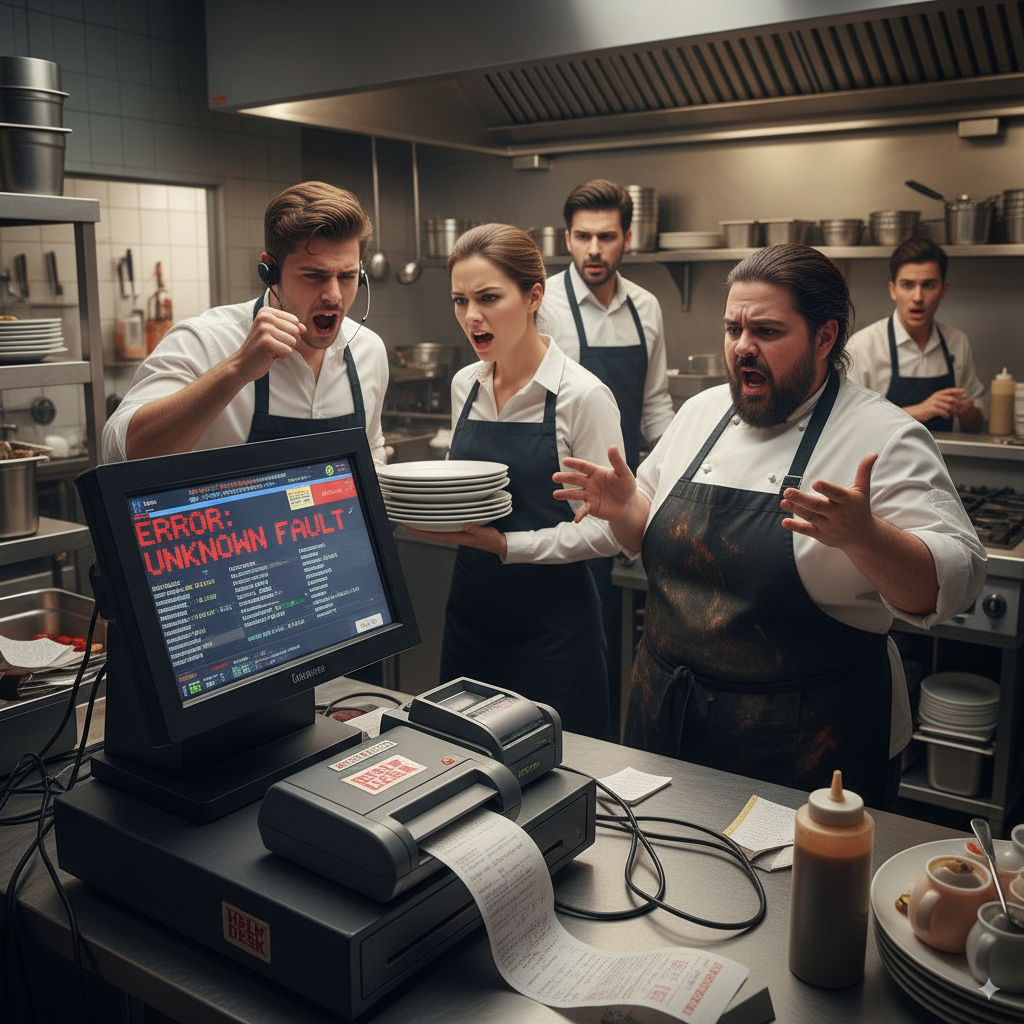When you’re running a restaurant, every dollar counts. So when it comes time to choose a point-of-sale (POS) system, that bargain-basement option might seem like the smart financial choice. After all, why spend thousands on a premium system when you can get something that “does the job” for a fraction of the price?
Here’s the uncomfortable truth: that cheap POS system is likely costing you far more than you realize. While the upfront savings might look attractive on paper, the hidden costs of inefficiency, downtime, and lost opportunities can devastate your bottom line in ways that compound over time.
The Real Price of “Cheap”
1. System Downtime = Direct Revenue Loss
When your POS system crashes during the dinner rush, you’re not just dealing with an inconvenience you’re bleeding money. A single hour of downtime during peak service can cost the average restaurant $2,000-$5,000 in lost sales, depending on your volume.
Cheap POS systems typically run on outdated hardware and unreliable software, making crashes and freezes far more common. While premium systems boast 99.9% uptime, budget alternatives often struggle to maintain 95% reliability. That 4.9% difference translates to roughly 18 additional hours of downtime per year.
The math is brutal: Even a modest restaurant losing $1,500 per hour of downtime faces an additional $27,000 in lost revenue annually more than enough to upgrade to a premium system.
2. Operational Inefficiency Drains Productivity
Every second your staff spends fighting with a slow, clunky POS system is time stolen from customer service. Cheap systems often suffer from:
- Slow processing speeds that create bottlenecks during busy periods
- Confusing interfaces that require extensive training and frequent mistakes
- Limited customization that forces workarounds for your specific menu and processes
- Poor integration with other systems, requiring duplicate data entry
Consider this: if your POS system adds just 30 seconds to each transaction, and you process 200 transactions daily, that’s 100 minutes of wasted time every day. Over a year, that’s nearly 610 hours equivalent to hiring an additional part-time employee at $15/hour costs you over $9,000 annually in lost productivity.
3. Staff Frustration Leads to Higher Turnover
Restaurant staff already face high-stress environments. Adding a frustrating, unreliable POS system to their daily challenges only makes things worse. When servers have to restart crashed terminals, managers can’t access real-time reports, and kitchen staff deal with garbled orders, job satisfaction plummets.
The restaurant industry already struggles with turnover rates exceeding 75%. A difficult-to-use POS system can push good employees over the edge, contributing to costly recruiting and training cycles. With the average cost to replace a restaurant employee ranging from $2,000-$5,000, even preventing one additional resignation per year pays for a significant system upgrade.
4. Data Disasters and Security Vulnerabilities
Cheap POS systems often skimp on security features and data backup protocols. This creates multiple risks:
- Payment data breaches that can result in massive fines and legal liability
- Lost sales data from system crashes or inadequate backups
- Compliance violations with payment card industry (PCI) standards
- Identity theft concerns that can destroy customer trust
A single data breach can cost a small restaurant $120,000 on average in fines, legal fees, and remediation costs far exceeding the price difference between budget and premium POS systems.
5. Missed Revenue Opportunities
Modern POS systems do more than just process payments—they’re powerful business intelligence tools. Cheap systems typically lack:
- Advanced reporting and analytics to identify profitable menu items and optimal pricing
- Customer relationship management features to build loyalty and encourage repeat visits
- Inventory management integration to reduce waste and optimize ordering
- Marketing automation to drive additional sales through targeted promotions
These missed opportunities represent hidden costs that compound over time. A restaurant that can’t identify its most profitable items or track customer preferences is leaving money on the table every single day.
The Ripple Effect
The problems with cheap POS systems don’t exist in isolation they create cascading effects throughout your operation:
Poor customer experience leads to negative reviews and reduced repeat business. When orders take longer to process, mistakes are more frequent, and payment processing is unreliable, customers notice.
Management blind spots prevent data-driven decision making. Without accurate, real-time reporting, you can’t optimize your menu, staffing, or inventory effectively.
Vendor lock-in occurs when cheap systems use proprietary formats or charge excessive fees for data export, making it expensive to upgrade later.
Scalability limitations mean your POS system becomes a bottleneck as your business grows, forcing premature replacements.
Making the Smart Investment
When evaluating POS systems, consider the total cost of ownership over 3-5 years, not just the upfront price. Factor in:
- Reliability and uptime guarantees
- Processing speed and user experience
- Security features and compliance support
- Integration capabilities with other business tools
- Quality of customer support and training
- Scalability for future growth
The bottom line: A quality POS system should pay for itself through improved efficiency, reduced downtime, and enhanced revenue opportunities. The most expensive system is often the cheapest one you buy.
Take Action Today
If you’re currently struggling with a cheap POS system, calculate your hidden costs:
- Track downtime incidents and estimate lost revenue
- Measure transaction times and staff productivity impacts
- Assess your turnover rates and associated costs
- Evaluate missed opportunities from lack of data insights
The results might surprise you and justify an immediate upgrade to a system that truly supports your business success.
Remember: in the restaurant business, your POS system isn’t just a tool it’s the nervous system of your operation. Invest in reliability, efficiency, and growth potential, and your bottom line will thank you.
📍 Secure Hospitality Solutions is here to be your local partner in reliable POS and restaurant tech.
💻 Learn more about our approach to local support »


